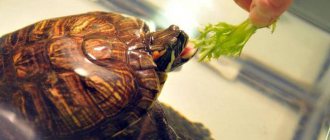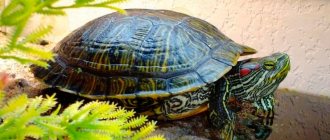Knowledge about the diseases of red-eared turtles when keeping them at home will help you provide the necessary assistance yourself or immediately contact a veterinarian. The experience of specialists shows that it is better not to wait for characteristic symptoms to develop, but to pay attention to the first signs of the disease. They make it quite easy to identify problems and take appropriate action.
To avoid diseases, you must follow certain rules for caring for the red-eared turtle.
Pneumonia
As it turns out, pneumonia can develop not only in humans, but also in turtles. This happens when the reptile’s body becomes hypothermic. The disease is considered serious, and if the pet does not receive timely treatment, there is a risk of death.
Signs of the disease can be noticed within 24 hours after the onset of the inflammatory process. The reptile will be on land or swimming on the surface more often, as it will lose the ability to dive. Pneumonia is treated with medication or using traditional recipes. It is possible to achieve the greatest efficiency only with an integrated approach:
- Intramuscular injections (drugs "Baytril", "Amikacin") are required - consultation with a veterinarian is required, as it is important to determine the exact dosage. If the dose is determined incorrectly, the medicine will not only not help, but can also lead to the death of the turtle.
- Methods of traditional medicine - steam inhalations and warm baths with a decoction of chamomile flowers have a high effect. The reptile is first held over steam and then immersed in liquid for 25-30 minutes. The optimal temperature of the solution for the treatment of pneumonia should not be higher than 30°C.
Signs of illness
The main symptomatic manifestations of turtle diseases:
- the animal stays on the surface of the water for a long time;
- swelling of the eyes, purulent discharge;
- weakness;
- loss of appetite;
- feces with blood;
- white coating;
- shell detachment;
- softness of the shell;
- foam at the mouth.
Another warning sign is a long stay at the bottom of a reservoir, although in some cases turtles may simply fall asleep at the bottom. This will not mean that she has any health problems, but she needs to be woken up and moved to another place, otherwise the animal may die.
If there are any signs of illness, the turtle should be shown to a specialist. Don't put off visiting your doctor.
Eye diseases
If the eyes of turtles are not the weakest point, they still deserve special attention, since diseases of this particular organ often occur. Most often, the owners of these pets are faced with a problem such as redness and swelling of the eyes. In most cases, pathology occurs due to poor or unbalanced nutrition and living in polluted water.
In order for reptiles to avoid such a disease, the following is necessary:
- the redfish menu should include foods containing large amounts of carotene;
- The water needs to be changed regularly.
Eye swelling and hyperemia can be treated at home. A sick reptile is placed in a separate tank, where it will not be able to dive into water on its own. The pet is allowed to swim for 2-3 hours, but the water level should not be such that it is completely submerged.
Complex treatment includes the following activities:
- eyes are treated with a 3% solution of orthoboric acid;
- An ointment containing an antibiotic is applied to the affected organs.
After the swelling and hyperemia go away, food containing a lot of vitamin A is included in the reptile's diet.
Prevention
Prevention of trigeminal neuralgia is a set of simple measures that significantly reduce the risk of developing pathology. Doctors recommend:
- undergo regular preventive examinations;
- at the first signs of the disease, seek help (the sooner treatment is started, the greater its effect will be);
- eat right, get the required amount of vitamins, minerals, unsaturated fatty acids;
- regularly engage in light sports and gymnastics;
- get enough sleep and rest;
- minimize stress and physical overload;
- avoid hypothermia and harden yourself;
- to refuse from bad habits.
Detachment of horny plates
In reptiles that have a shell, some diseases affect even this strong part of the body. In ordinary life, turtles do not break off parts of the carapace, although when an individual is actively growing, this is also possible.
But with age, the redfish begins to grow more and more slowly. If its plates peel off, the owner should worry - this is one of the reactions to a violation of the conditions of detention. The main reasons for this phenomenon are as follows:
- dehydration;
- damage by pathogenic fungal organisms;
- infection with cyanobacteria;
- deficiency of some vitamin components.
If the shield leaves its rightful place evenly, repeating the shape of the substrate, then we are not talking about serious diseases. You should be concerned if there are a number of signs:
- The plate delaminates, and cavities and small bubbles appear in it . This is a sure sign of a fungal infection. If the inner side of the fallen shield or the surface of the regrown plate is covered with a brown crust or grayish coating, then the possibility of a pathogenic process can be excluded. The point is that fungi can only live on dead tissue. A similar thing is observed when blue-green algae penetrates tissue.
- The shield thickens (hypertrophies), and detachment occurs from the middle, from the deep layers . In most cases, you can save your pet from such a nuisance by adjusting the diet - it must be balanced. Also, the sick turtle is prescribed suitable vitamin and mineral formulations.
- The stratum corneum peels off in the same areas, soft, light spots form. Sometimes under the scutes you can see a fibrous membrane - the periosteum, when wiped with a cotton swab, blood appears. This is a dangerous sign, signaling the development of shell ulcer disease, which English zoologists designate USD. It is caused by pathogenic bacteria.
Therapy for detachment of horny plates includes the following procedures and measures:
- first of all, in case of any violations in the condition of the shell, the conditions in which the reptile is kept should be corrected;
- It is recommended to add a small amount of methylthionium chloride to the water for several weeks until it turns blue;
- for carapace ulcers, in addition to adding blue, it is necessary to use the antifungal drug “Clotrimazole” in the form of an ointment;
- if required, medications with antimycotic effects are prescribed.
It is important to consider that when treating such turtle pathologies, reptiles require some changes in living conditions. It is advisable that they spend the night time on land.
Treatment of trigeminal neuralgia
Treatment is aimed at:
- to eliminate the cause of damage;
- to alleviate the patient's condition;
- to stimulate the restoration of nerve structures;
- to reduce the excitability of trigger zones.
Properly selected treatment can reduce the frequency, intensity and duration of pain waves, and ideally achieve stable remission.
Drug treatment
Trigeminal neuralgia requires complex treatment using drugs from several groups:
- anticonvulsants (carbamazepine and analogues): reduce the excitability of nerve fibers;
- muscle relaxants (baclofen, mydocalm): reduce muscle spasms, improve blood circulation, reduce pain;
- B vitamins (neuromultivit, milgamma): stimulate the restoration of nerve fibers, have an antidepressant effect;
- antihistamines (diphenhydramine): enhance the effect of anticonvulsants;
- sedatives and antidepressants (glycine, aminazine): stabilize the patient’s emotional state.
For severe pain, narcotic analgesics may be prescribed. Previously, drug blockades (injecting the problem area with anesthetics) were actively used, but today this method of treatment is almost never used. It contributes to additional damage to nerve fibers.
Treatment of the root cause of the disease is mandatory: elimination of dental problems, taking medications to improve cerebral circulation, etc.
Physiotherapy and other non-drug methods
Non-drug methods complement drug therapy well and help stabilize patients’ condition. Depending on the condition and concomitant diseases, the following may be prescribed:
- ultraviolet irradiation: inhibits the passage of impulses along nerve fibers, providing an analgesic effect;
- laser therapy: reduces pain;
- UHF therapy: improves microcirculation and prevents muscle atrophy;
- electrophoresis with analgesics or antispasmodics to relieve pain and relax muscles;
- diadynamic currents: reduce the conductivity of nerve fibers, significantly increase the intervals between attacks;
- massage of the face, head, cervical-collar area: improves blood circulation and lymph outflow, improving tissue nutrition; must be carried out with caution so as not to touch trigger zones and provoke an attack; the course is carried out only during the period of remission;
- acupuncture: helps relieve pain.
Surgery
The help of surgeons is indispensable when it is necessary to eliminate nerve compression. If indicated, the following is carried out:
- removal of tumors;
- displacement or removal of dilated vessels pressing on the nerve (microvascular decompression);
- expansion of the bone canals in which the branches of the nerve pass.
A number of operations are aimed at reducing nerve fiber conductivity:
- exposure to a gamma knife or cyber knife;
- balloon compression of the trigeminal node: compression of the node using an air-filled balloon installed in close proximity to it, followed by death of the nerve fibers; surgery often leads to partial loss of sensation and decreased muscle movement;
- resection of the trigeminal node: rarely performed due to the complexity and large number of complications.
Make an appointment
Exfoliation of the skin
This condition can occur both during the active growth of reptiles and during the development of various diseases. Detachment of skin flakes also often occurs against the background of mechanical damage or a dermatological disease. In addition, the following causes of peeling skin in turtles can be identified:
- deficiency of vitamin components - vitamins A and group B;
- overdose of vitamins – often occurs when the owner introduces vitamin complexes into the pet’s diet without consulting a veterinarian or does not comply with the recommended dosage. In the case of reptiles, when determining the correct dose, not only the size of the individual is taken into account, but also its species, living conditions and feeding diet.
To understand what caused this symptom, it is advisable to show the turtle to a specialist. He will conduct an examination, diagnose and prescribe a suitable therapeutic regimen, as well as give a number of useful recommendations.
Diagnostics
A neurologist diagnoses trigeminal neuralgia. During the first visit, he carefully interviews the patient to find out:
- complaints: nature of pain, its intensity and localization, conditions and frequency of attacks, their duration;
- medical history: when pain attacks first appeared, how they changed over time, etc.;
- life history: the presence of chronic diseases, previous injuries and operations is clarified, special attention is paid to dental diseases and interventions.
A basic examination includes assessing the condition of the skin and muscles, identifying asymmetry and other characteristic signs, checking the quality of reflexes and skin sensitivity.
To confirm the diagnosis, the following is carried out:
- MRI of the brain and spinal cord with or without contrast: allows you to identify tumors, consequences of injuries, vascular disorders; sometimes the study is replaced by computed tomography (CT), but it is not as informative;
- electroneurography: study of the speed of nerve impulse transmission through fibers; allows you to identify the fact of nerve damage, assess the level of the defect and its features;
- electroneuromyography: not only the speed of impulse passage along the nerve bundle is studied, but also the reaction of muscle fibers to it; allows you to assess nerve damage, as well as determine the sensitivity threshold of trigger zones;
- electroencephalography (EEG): assessment of the bioelectrical activity of the brain.
Laboratory diagnostics includes only general studies to exclude other causes of painful attacks, as well as to assess the condition of the body as a whole (usually a general blood and urine test is prescribed, as well as a standard set of biochemical blood tests). If the infectious nature of the disease is suspected, tests are carried out to identify specific pathogens or antibodies to them.
Additionally, consultations with specialized specialists are prescribed: ENT specialist (if there are signs of nasopharynx pathology), a neurosurgeon (if there are signs of a tumor or injury), and a dentist.
Diseases caused by pathogenic fungi
Often, owners of red-eared and other aquatic turtles are faced with the fact that their pets are covered with spots and a coating that looks like a layer of cotton wool. A similar disease can be found not only in turtles, but also in other aquarium reptiles. Most often, the cause of this symptom is fungi, and to combat them the following actions must be taken:
- treatment of damaged areas with a 1% solution of potassium permanganate, a similar procedure is carried out within 3-5 days;
- additionally, antifungal ointment is applied to the tissue - “Exifin”, “Atifin” and other analogues;
- All items in the aquarium must be disinfected - they will have to be boiled.
Diarrhea
Freshwater animals, as well as humans, may experience disorders of the digestive system. They can be caused by consumption of low-quality and stale food. This disease can also appear as a result of intestinal injury.
Note! Determining the presence of diarrhea is not difficult. During this illness, the turtle may notice liquid or mushy feces, which may have a strong, unpleasant odor.
What to do at home if your pet has diarrhea:
- food intake is limited during the week;
- Every day the turtle must be bathed in warm water;
- the reptile must drink enough water;
- Every day it is necessary to weigh the animal, this is necessary to control body weight.
Bone diseases
Signs of rickets, detachment and softening of the shell appear for the same reasons: due to insufficient absorption of calcium and other elements necessary for this process, as well as due to a deficiency of ultraviolet radiation. The main symptom of the pathology is thickening of the bones, while their structure and shape are disrupted.
It is difficult, but possible, to detect softening of bone tissue at the initial stage. If you carefully observe your pet, you will notice that the turtle has become lethargic and moves less than usual. This is exactly how reptiles with bone problems behave. If the shell has already softened, this is noticeable immediately: initially, the keratinized particles begin to peel off, and then the hard structure of the shield is replaced by a soft one, and perhaps even a change in shape.
You should consult your veterinarian before treating your turtle for bone disease. He will determine the causes of the disease and prescribe appropriate therapy. Most often it consists of taking vitamin and mineral preparations: Eleovita, Intravita, Multivita. If required, treatment is supplemented with other measures.
If you have bone diseases, your pet's diet needs to be adjusted. Redfish are given small fish with bones. In addition, for preventive purposes, it is recommended to place the reptile under a UV lamp, starting with 5-minute procedures, gradually increasing the time.
Treatment at the Energy of Health clinic
If you or your relative are bothered by severe pain in one or another part of the face, the neurologists of the Health Energy clinic will come to the rescue. We will conduct a full diagnosis to identify the causes of the pathology and prescribe comprehensive treatment. At your service:
- modern drug regimens to reduce the frequency and intensity of attacks;
- physiotherapeutic procedures: magnetotherapy, laser therapy, electrophoresis, phonophoresis, etc.;
- delicate therapeutic massage;
- acupuncture;
- help from a psychologist if necessary.
Eye infections
Diseases of the visual organs in red ear are most often diagnosed:
- Conjunctivitis can be caused by dirty water in the aquaterrarium, staphylococci and streptococci. It can also be observed against the background of rickets, pneumonia, and vitamin deficiency. The fact that a reptile has conjunctivitis is indicated by a number of symptoms: the eyes are red, pus is released from them, and the eyelids are swollen. The pet’s general well-being also suffers: it becomes lethargic, does not eat anything, and is indifferent to what is happening. The reptile constantly rubs its sore eyes with its front paws; in advanced cases, the eyes close completely. In case of illness, antibiotics are indicated.
- Panophthalmitis occurs when germs penetrate under the cornea of the eye. This disease causes clouding of the eye and damage to the lower eyelid. Antibiotic therapy is prescribed, and sometimes removal of the eye is required. What to do if this pathology develops should only be decided by a doctor.
Hibernation
The winter period is characterized by hibernation for red-eared turtles. However, this is a characteristic phenomenon for individuals that live in captivity. This should not be allowed in a home atmosphere. There are a number of reasons why hibernation is contraindicated for turtles. A number of them:
- Lack of information on how to monitor and maintain a stable condition of the turtle;
- Lack of suitable conditions for hibernation;
- Many small and sick turtles do not survive the hibernation period.
In captivity, red-eared turtles burrow under bushes and mud near bodies of water with shallow depths. Oxygen is absorbed through the openings of the mouth, pharynx and cloaca. The temperature regime of the reservoir is important, as well as the presence of an acceptable amount of oxygen in the water for safe hibernation. In order to invigorate the turtle, you need to keep the water temperature at least 26 degrees Celsius, since low temperatures contribute to hibernation.
How to tell if your pet turtle is sick
It is important to constantly monitor your pet.
The red-eared turtle is dangerous to humans because it can be a carrier of salmonellosis, worms or fungus
As soon as any change in behavior, appearance, strange discharge or similar things appear, then you should be wary and take a closer look at it, as usual.
If the owner wants his turtle to be healthy, then he should properly care for it and pay more attention to the behavior of the animal.
Even one illness can lead to others, more severe and dangerous.
Aquarium content
Temperatures for baby red-eared turtles should be different from their adult counterparts. For land it is 32 degrees Celsius, and for water - no more than 26 degrees Celsius . Choose a long aquarium that is not very wide and tall. The volume of water must be at least 120 liters. Adjust the water level according to the proportions of the turtle's shell. It should be able to roll over. At the edge of the aquarium, arrange a land shore in the form of an island. Such an island can be purchased at pet stores, or you can build it yourself.
The water must be constantly cleaned. Special filters are sold for this purpose. If there are only young turtles in your aquarium, then use an external filter, and if they are already adults, use an internal one. An additional device can be used with an ultraviolet lamp, which must be placed at a height of up to 25 centimeters. Incandescent lamps are suitable for heating water and sushi. Turn off all lamps at night. Please note that the lamps may be splashed with water, so they should be hidden from moisture and evaporation. When the weather is good, it is a good idea to take the aquarium out onto the balcony to warm up, but no more than 5 minutes for the first time. Increase the time spent in the open space gradually as the turtles need to get used to it.











